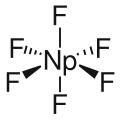Neptunium hexafluoride
 | |
| Names | |
|---|---|
| IUPAC name
Neptunium(VI) fluoride | |
| Identifiers | |
| 14521-05-2 | |
| 3D model (Jmol) | Interactive image |
| PubChem | 19695135 |
| |
| |
| Properties | |
| F6Np | |
| Molar mass | 350.99 g·mol−1 |
| Appearance | orange crystals |
| Melting point | 54.4 °C (129.9 °F; 327.5 K) |
| Boiling point | 55.18 °C (131.32 °F; 328.33 K) |
| Structure | |
| Orthorhombic, oP28 | |
| Pnma, No. 62 | |
| octahedral (Oh) | |
| 0 D | |
| Related compounds | |
| Related fluoroNeptuniums |
Neptunium trifluoride Neptunium tetrafluoride |
| Except where otherwise noted, data are given for materials in their standard state (at 25 °C [77 °F], 100 kPa). | |
| | |
| Infobox references | |
Neptunium hexafluoride (NpF6) is the highest fluoride of neptunium. It is an orange volatile crystalline solid.[1] It is relatively hard to handle, being very corrosive and radioactive. It is prepared by fluorination of Neptunium(IV) fluoride (NpF4) by powerful fluorinating agents such as elemental fluorine.[2]
- NpF
4 + F
2 → NpF
6
It can also be obtained by fluorination of neptunium(III) fluoride.[3]
- 2 NpF
3 + 3 F
2 → 2 NpF
6
References
- 1 2 Gmelins Handbuch der anorganischen Chemie, System Nr. 71, Transurane, Teil C, p. 108–114.
- ↑ John G. Malm, Bernard Weinstock, E. Eugene Weaver: „The Preparation and Properties of NpF6; a Comparison with PuF6“, J. Phys. Chem., 1958, 62 (12), p. 1506–1508 (doi:10.1021/j150570a009).
- ↑ Sherman Fried, Norman Davidson: „The Preparation of Solid Neptunium Compounds“, J. Am. Chem. Soc., 1948, 70 (11), p. 3539–3547 (doi:10.1021/ja01191a003).
This article is issued from Wikipedia - version of the 7/26/2016. The text is available under the Creative Commons Attribution/Share Alike but additional terms may apply for the media files.